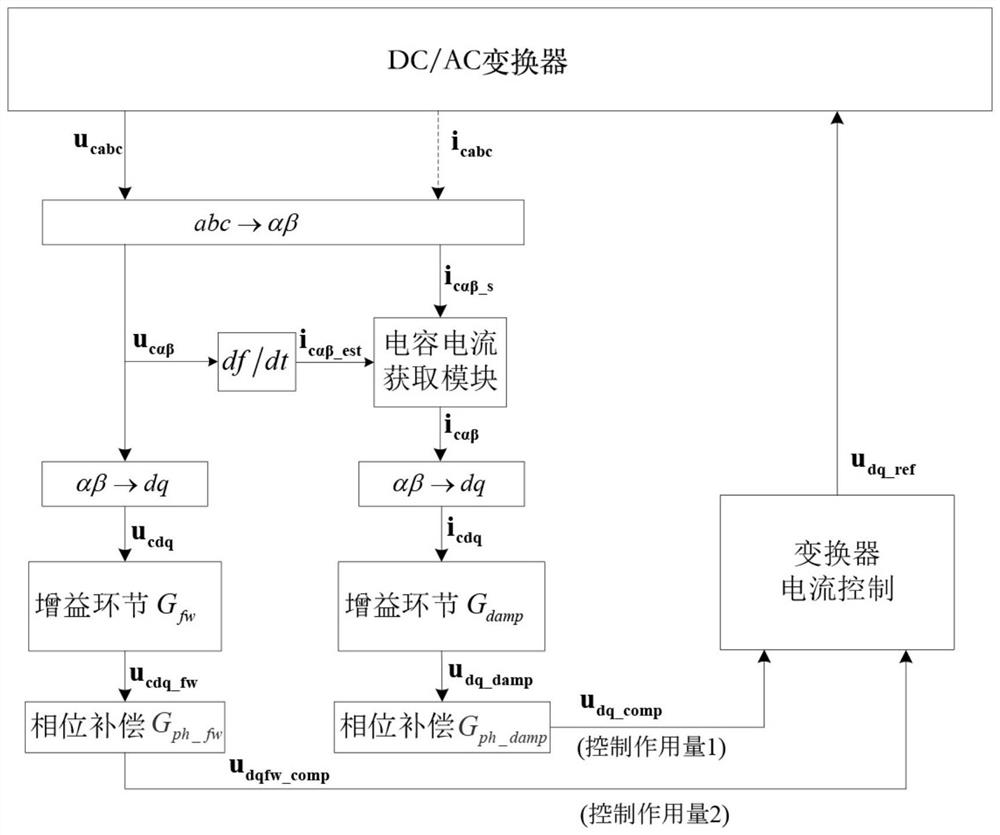Resonance suppression method, module and device of converter
A resonance suppression and converter technology, applied in the field of control, can solve problems such as limited resonance damping capacity, achieve the effects of avoiding the limitation of resonance damping capacity, reducing resonance risk, and enhancing stable operation capability
- Summary
- Abstract
- Description
- Claims
- Application Information
AI Technical Summary
Problems solved by technology
Method used
Image
Examples
Embodiment 1
[0054] Such as figure 1 As shown, Embodiment 1 of the present application provides a method for suppressing resonance of a converter, the method comprising:
[0055] Step S11, obtaining the capacitive current component of the AC side of the converter;
[0056] Step S12, after adjusting the capacitive current component through the first gain link and the first phase compensation link, the first control action amount is obtained;
[0057] Step S13, adding the first control action to the controller output of the converter to form a final control action.
[0058] In this example, the first gain link includes a pure proportional link and / or a functional module with filtering characteristics. The transfer function of the input and output characteristics of the first phase compensation link includes a FIR filter function.
[0059] In this way, by introducing a phase compensator with an input-output characteristic transfer function including an FIR filter function in the capacitive...
Embodiment 2
[0066] Such as figure 2 As shown, different from Embodiment 1, the method also includes:
[0067] Step S21, obtaining the capacitive voltage component on the AC side of the converter;
[0068] Step S22, after adjusting the capacitor voltage component through the second gain link and the second phase compensation link, a second control action is obtained;
[0069] Step S23, adding the first control action amount and the second control action amount to the controller output of the converter to form a final control action amount.
[0070] It should be noted that the steps of obtaining the first control action (S11 and S12) and the steps of obtaining the second control action (S21 and S22) can be performed in no order, for example: the first control action can be obtained first, Then get the second control action; you can also get the second control action first, and then get the first control action; or get the two action at the same time.
[0071] In this example, the second...
Embodiment 3
[0074] image 3 It is a schematic diagram of the resonance suppression implementation process of the converter in the third embodiment of the present application.
[0075] The control action 1 can be obtained through the following steps: First, obtain the dq component i of the capacitive current on the AC side of the converter cdq , then the component i cdq Through the gain link G damp and phase compensation link G ph_damp , you can get it. Specifically, the component i cdq Through the gain link G damp Then get the initial control action u dq_damp , u dq_damp Then through the phase compensation link G ph_damp after getting u dq_comp , u dq_comp That is, the control action 1. G damp It can be a pure proportional link, or a module with filtering function, or a combination of both.
[0076] Among them, the dq component i of the capacitive current on the AC side of the converter cdq It can be obtained by:
[0077] Method 1: For the vector u of the capacitor voltage ...
PUM
 Login to View More
Login to View More Abstract
Description
Claims
Application Information
 Login to View More
Login to View More - R&D
- Intellectual Property
- Life Sciences
- Materials
- Tech Scout
- Unparalleled Data Quality
- Higher Quality Content
- 60% Fewer Hallucinations
Browse by: Latest US Patents, China's latest patents, Technical Efficacy Thesaurus, Application Domain, Technology Topic, Popular Technical Reports.
© 2025 PatSnap. All rights reserved.Legal|Privacy policy|Modern Slavery Act Transparency Statement|Sitemap|About US| Contact US: help@patsnap.com



